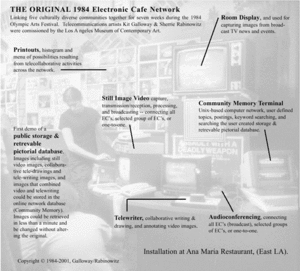1984 - Ecafe Manifesto - Kit Galloway & Sherrie Rabinowitz

Texto
ECAFE MANIFESTO.
THE CHALLENGE: WE MUST CREATE AT THE SAME SCALE AS WE CAN DESTROY
If the arts are to take a role in shaping and humanizing emerging technological environments, individuals and arts constituencies must begin to imagine at a much larger scale of creativity.
We must begin to create at the same scale as we can destroy, or else art, and more dangerously the human spirit and imagination, will be rendered decorative and impotent.
If the boundaries between art and life dissolve it will be the result of artists migrating towards a new order of artmaking, abandoning the conventional standards and practices and becoming 'new practitioners' or systems integrators, who produce situations, contexts, and permanent environments or utilities. The 'new practitioners' can begin the process of healing the aesthetic wound that has disfigured the business of Art, and continue the aesthetic quest in more relevant directions.
New creative activities must emerge such as multi-media creative solutions networks, not simply computer networks for Artists, but rather multi-media telecommunications networks with agendas that can engage multi-disciplinary constituencies. This will require the development of new skills and the cultivation of new relationships between the participants. The movement is towards the control of a meaningful context, creating environments not just to support art, but that create the possibility for new scales of creativity across all disciplines and boundaries.
The dark side of the "new world information order" suggests that a new scale aesthetics be created. It will take several years from the time this work begins for creative solutions networks of appropriate number, scale, velocity, and dexterity to evolve to maturity. Consider: co-creating non-imperialistic, multi-cultural or domestic agendas for community or global scale aesthetic endeavors. Consider: the continuous re-invention of non-hierarchical telecom networks that will allow people to bypass cultural gatekeepers and power brokers. We must accept these kinds of challenges and recognize what can be gained by solving them.
All of this implies that there is a new way to be in the world. That the counterforce to the scale of destruction is the scale of communication, and that our legacy or epitaph will be determined in many ways by our ability to creatively employ informal, multi-media, multi-cultural, conversational, telecommunications and information technologies.
Contexto
El manifiesto se concibió como parte del Electronic Cafe Network Project creado en 1984 por Kit Galloway y Sherrie Rabinowitz para el Summer Olympics Arts Festival de Los Ángeles (Estados Unidos). La idea era proponer "una red de nuevas instituciones informales para exhibir, encontrar, humanizar y aculturar las tecnologías que cambian el mundo"(1), en respuesta a las actividades generadas en torno al año orwelliano. El objetivo era integrar "la comunidad, el arte, la tecnología, las telecomunicaciones multimedia y las comunicaciones transculturales. La misión técnica era definir los requisitos humanos básicos para facilitar una 'conversación creativa' entre las personas, incluso si no hablaban el mismo idioma"(2). El Proyecto se instaló y se puso en funcionamiento durante siete semanas, conectando comunidades culturalmente diversas en todo el área metropolitana de Los Ángeles (2). En 1987 lanzaron Electronic Cafe International (3).En 2001 el proyecto formó parte de la exposición Telematic Connections: The Virtual Embrace curada por Steve Dietz cuya web conserva el Walker Art Center (4)
Autoras
Desde 1975 Kit Galloway y Sherrie Rabinowitz han enfocado su colaboración artística en el desarrollo de estructuras nuevas y alternativas para la comunicación interactiva. Sus trabajos más destacados son: Satellite Arts Project (1977), Hole-In-Space (1980) y Electronic Cafe (1984). Ambos combinan las posibilidades tecnológicas y sociológicas de las comunicaciones bidireccionales con la sensibilidad artística para crear modelos elegantes de cómo podrían ser las cosas. Estos "modelos", un término que prefieren al de "obras de arte", sirven no solo como una visión de cómo las telecomunicaciones podrían servir a la humanidad, sino que también presentan algunas nociones provocativas del futuro y la función del artista (5).
Archivo
Archivo:ECI MANIFESTO FOR 1984.pdf
Fuentes
(1) http://www.ecafe.com/museum/about_festo/84manifesto.html
(2) http://www.ecafe.com/museum/history/ksoverview2.html
(3) Galloway, K. & Rabinowitz, S. (1992). WELCOME TO "ELECTRONIC CAFE INTERNATIONAL". A NICE PLACE FOR HOT COFFEE, ICED TEA, & VlRTUAL SPACE. En Linda Jacobson (ed.), CyberArts: Exploring Art & Technology. Miller Freeman. Recuperado de: http://www.ecafe.com/museum/cyberart92/Welcome_to_ECI.html
(4) http://telematic.walkerart.org/timeline/timeline_ecafe.html
(5) Durland, S. (1987). Defining the image as place. A conversation with Kit Galloway, Sherrie Rabinowitz & Gene Youngblood. HIGH PERFORMANCE A Quarterly Magazine for the New Art Audience, 37. Recuperado de: http://www.ecafe.com/museum/hp_gy_1987/hp_gy_1987.html
Enlaces
Primera edición: http://www.ecafe.com/museum/about_festo/84manifesto.html
URL: http://www.ecafe.com/museum/about_festo/84manifesto.html, http://telematic.walkerart.org/timeline/timeline_ecafe.html
Wayback Machine: http://www.ecafe.com/museum/about_festo/84manifesto.html, https://web.archive.org/web/20180316235052/http://telematic.walkerart.org/timeline/timeline_ecafe.html
